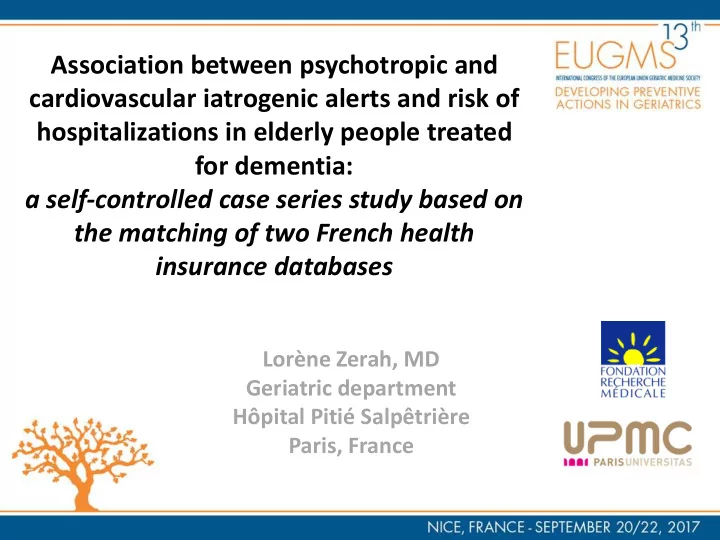

Association between psychotropic and cardiovascular iatrogenic alerts and risk of hospitalizations in elderly people treated for dementia: a self-controlled case series study based on the matching of two French health insurance databases Lorène Zerah, MD Geriatric department Hôpital Pitié Salpêtrière Paris, France
CONFLICT OF INTEREST DISCLOSURE I have no potential conflict of interest to report
Background • Between 5% and 20% of all hospital admissions are known to be related to adverse drug events (ADE) in people aged ≥ 65 years, and 40% to 70% of these admissions could be preventable • This has prompted the development of criterion-based tools , based on explicit measures, to assess and correct inappropriate prescription in elderly people • However, the evidence that inappropriate prescription , as defined by the explicit measures, is associated with adverse patient outcomes, and notably hospitalizations, is mixed and contradictory Budnitz, NEJM, 2011 Gurwitz, JAMA, 2003 Budnitz, JAMA, 2006 Pirmohamed, BMJ, 2004 Hanlon, Ann Pharmacother, 2010
Background • In 2011 , the French National Authority for Health commissioned a panel of French health professionals to determine the most important criteria for cardiovascular and psychotropic drugs known to be involved in ADE-related admissions • Five iatrogenic alerts (IAs) were identified which were easy to assess and clinically relevant for the prevention of serious ADE in the elderly, based on a literature search and the panel members’ clinical experience 3 PSYCHOTROPIC IAs • The prescription of a long-half benzodiazepine • The prescription of antipsychotic drug in Alzheimer patients • The co-prescription of 3 or more psychotropic drugs 2 CARDIOVASCULAR IAs • The co-prescription of 2 or more diuretics • The co-prescription of 4 or more antihypertensive drugs http://www.has-sante.fr/portail/jcms/c_927429/fr/references-has-pmsa
Objectives • The aim of our study was to validate this new screening tool for inappropriate prescriptions in elderly people, by measuring the association between these IAs and the risk of all-cause hospitalizations • We focused on patients treated for Alzheimer disease because they are at high risk of hospitalizations and because one of the IAs was specific for this population
Design • Between January 1, 2011 and December 31, 2012 a longitudinal, national database study based on the “ self-controlled case series ” methodology was performed Period 4 Period 1 Period 2 Period 3 January July Januar July December y 2012 2012 2011 2011 2012 Epidemiologic study design in which individuals act as their own controls: comparing each patient to themselves in a different period
« RSI » database: Social security scheme for self-employed individuals • Ambulatory drug delivery and Hospitalization (private hospitals) • 1/01/2011- 31/12/2012 • Patients > 75 years old • N = 308 588 • No dementia: N = 280 024 • Untreated dementia : N = 16368 « SNIIRAM » database : French National Health Insurance Information System Patients treated for dementia • Hospitalization (public (ICD 10 code Alzheimer’s disease: F00 - hospitals) F03 AND drug code ATC: NO6D) N = 12196 Database matching unsuccessful N = 1408 Patients with repeat planned admissions N = 34 • Chemotherapy • Dialysis • Reeducation session Patients aged > 75 years receiving treatment for Alzheimer’s disease and available data on drug prescriptions, hospitalizations in public and private hospitals N = 10754
Results N = 10754 Population totale Age (years, mean +/- SD) 85 +/- 5 Sex (% female) 61.1% Comorbidities - Cardiovascular diseases 29% - Neuropsychiatric diseases 10 % - Cancer 12% Charlson Comorbidity Index 5.5 +/- 1.0 Polypharmacy (% per 6-month period) 90% Death (% per year) 10%
Results Population IA long-half benzodiazepine 9.7% IA one antipsychotic drug 16.5% IA co-prescription of 3 or more psychotropic drugs 15.5% IA 3 or more diuretics 5.9% IA co-prescription of 4 or more antihypertensive drugs 5.4% (% per 6-month period)
Results: all-cause hospitalizations and IAs Proportional Fold Attributable Change risk 1.95 [1.8, 2.1] At least one IA (per 6-month period) 22% 1.65 [1.5, 1.8] Long-half benzodiazepine 5% 1.79 [1.7, 1.9] One antipsychotic drug 9% ≥ 3 psychotropic drugs 2.04 [1.9, 2.2] 12% ≥ 2 diuretics 1.73 [1.5, 2.0] 3% ≥ 4 antihypertensive drugs 2.08 [1.8, 2.3] 5%
Results: all-cause hospitalizations and IAs Proportional Fold Attributable Change risk 1.95 [1.8, 2.1] At least one IA (per 6-month period) 22% 1.65 [1.5, 1.8] Long-half benzodiazepine 5% 1.79 [1.7, 1.9] One antipsychotic drug 9% ≥ 3 psychotropic drugs 2.04 [1.9, 2.2] 12% ≥ 2 diuretics 1.73 [1.5, 2.0] 3% ≥ 4 antihypertensive drugs 2.08 [1.8, 2.3] 5% All-cause hospitalizations rate doubled in a 6-month period when at least one IA was prescribed
Discussion Strengths of the study • First study to analyze the potential association between these IAs and hospitalizations in a selected population known to be at risk for repeated admissions: elderly people treated for dementia • Approach similar to the self-controlled case series – To reduce the bias of confusion – Lot of data are not available in these databases because their primary purpose is not medical but either administrative or for reimbursement – Self comparison automatically takes into account variables associated with hospitalization among the elderly : marital status, education, autonomy, place of living …
Discussion Limits of the study • We included only patients treated for Alzheimer disease – This could lead to an overestimation of the hospitalization rates and an overestimation of the prevalence of IAs • There was no code for ADE-related hospitalizations – Second analysis based on the major diagnosis category (MDC) – We adopted a minimalist approach, considering only poisoning and trauma as potentially ADE-related hospitalizations • With the sequential analysis, it was not possible to know whether the IA occurred before, during, or after the hospitalization within the same period
Conclusion • The risk of hospitalization nearly doubled in elderly patients being treatment for Alzheimer disease when they were exposed to psychotropic and/or cardiovascular IAs • Interventional studies are now needed to assess if the reduction of theses IAs could be associated with better clinical outcomes, particularly with reduction of hospital admissions
Recommend
More recommend